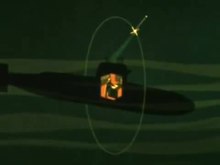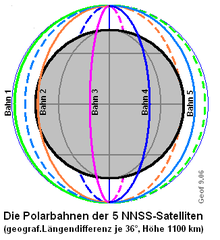Transit (satellite system)
Transit was the world's first satellite navigation system and the predecessor of the US GPS .
function
Its transmission frequencies were 150 and 400 MHz. Transit was developed by the US Navy from 1958, initially under the name Navy Navigation Satellite System ( NNSS or NAVSAT ), used for military purposes from 1964 and also for civil use from 1967. The Transit satellite system has been out of service since December 31, 1996.
It was the first functioning satellite navigation system ever, and was originally developed for the guidance of ballistic missiles on submarines and aircraft carriers of the United States Navy .
The accuracy was between 500 and 15 m depending on the receiving system. In the final phase of operation, the constellation consisted of six satellites , three in function and three as a backup system. They moved in a polar satellite orbit at an altitude of about 1200 km.
Measuring principle
The satellites sent their ephemeris and a time signal. The relative movement to the receiver caused a frequency shift of the carrier frequency due to the Doppler effect . In terms of quality, the change increased with the approach, and the faster the closer the satellite passes the receiver. Quantitatively, the carrier frequency changed from 400 MHz by a maximum of ± 9.8 kHz . From the transmitted time, the exact position of the satellites and the Doppler shift, it was possible to determine one's own position worldwide, including at the poles. The signal was also influenced by:
- the latitude of the receiver (the earth's rotation is greatest at the equator ).
- the receiver's own movement.
- the ionosphere .
In principle, the reception of signals from just one satellite was sufficient for calculating the position (instead of at least four as with GPS ), but it could take up to 30 minutes before the calculation result was available. In addition, the position calculation was only two-dimensional ( geographical longitude and latitude ), so the height could not be determined.
The Argos and DORIS systems also work according to the Transit principle .
Satellite system
Four ground stations operated by the Naval Astronautics Group (NAG) in Point Mugu ( California ), led the satellite and correction data transmitted every twelve hours. The transit satellites orbited the earth on polar orbits at an altitude of around 1200 km, but this decreased somewhat due to the slight braking caused by the high atmosphere . T. was corrected. The five to six orbit levels were swiveled evenly to each other (with 5 levels every 36 °, see picture).
Transit 4A, launched in 1961, was the first spacecraft powered by nuclear energy, the first time a radioisotope generator (RTG) was used in space.
Transit 5BN-3 did not reach orbit after launch on April 21, 1964. Upon re-entry, the satellite burned up, the plutonium contained in the RTG (type SNAP-9A) was released into the earth's atmosphere.
Start list
| Surname | Start date | Starting place | orbit | Launcher | Remarks |
|---|---|---|---|---|---|
| Transit 1A | 17th September 1959 | Cape Canaveral LC-17A | Thor-DM18 Able-2 (mod) | False start, weight 119 kg | |
| Transit 1B | April 13, 1960 | Cape Canaveral LC-17B | 373 km × 748 km, 51.28 ° | Thor DM21 Able Star | Weight 121 kg, together with Solrad model |
| Transit 2A | June 22, 1960 | Cape Canaveral LC-17B | 628 km × 1047 km, 66.69 ° | Thor DM21 Able Star | Weight 101 kg, together with Solrad 1 |
| Transit 2B | not started | ||||
| Transit 3A | November 30, 1960 | Cape Canaveral LC-17B | Thor DM21 Able Star | False start with Solrad 2, weight 91 kg | |
| Transit 3B | February 22, 1961 | Cape Canaveral LC-17B | 150 km × 847 km, 28.36 ° | Thor DM21 Able Star | together with LOFTI 1 (error during separation) |
| Transit 4A | June 29, 1961 | Cape Canaveral LC-17B | 881 km × 998 km, 66.81 ° | Thor DM21 Able Star | together with Injun 1, Solrad 3, mass 79 kg, SNAP-3A radioisotope generator |
| Transit 4B | November 15, 1961 | Cape Canaveral LC-17B | 956 km × 1106 km, 32.4 ° | Thor DM21 Able Star | together with TRAAC, weight 86 kg, SNAP-3 radioisotope generator |
| Transit 5A-1 | December 19, 1962 | Vandenberg SLC-5 | Scout-X3 | Failure after one day, weight 61 kg | |
| Transit 5A-2 | April 5, 1963 | Vandenberg SLC-5 | Scout-X3 | False start | |
| Transit 5A-3 | June 16, 1963 | Vandenberg SLC-5 | Scout-X3 | Mass 55 kg | |
| Transit 5BN-1 | September 28, 1963 | Vandenberg SLC-2E | Thor-DSV2A Able-Star | together with Transit 5E-1 , mass 70 kg, SNAP-9A radioisotope generator | |
| Transit 5BN-2 | 5th December 1963 | Vandenberg SLC-2E | Thor-DSV2A Able-Star | together with Transit 5E-2 , SNAP-9A radioisotope generator | |
| Transit 5BN-3 | April 21, 1964 | Vandenberg SLC-2E | Thor-DSV2A Able-Star | False start, with Transit 5E-3 , mass 75 kg, SNAP-9A radioisotope generator | |
| Transit 5C-1 (OPS 4412) |
3rd June 1964 | Vandenberg SLC-5 | Scout-X4 | Weight 54 kg | |
| Transit 5C-2 | not started | ||||
| Transit O-1 (NNS 30010, OPS 5798) |
October 6, 1964 | Vandenberg SLC-2W | Thor-DSV2A Able-Star | together with Dragsphere 1 and 2, weight 60 kg | |
| Transit O-2 (NNS 30020, OPS 6582) |
December 13, 1964 | Vandenberg SLC-2W | Thor-DSV2A Able-Star | together with Transit 5E-5 | |
| Transit O-3 (NNS 30030, OPS 7087) |
March 11, 1965 | Vandenberg SLC-2E | Thor-DSV2A Able-Star | together with SECOR 2 | |
| Transit O-4 (NNS 30040, OPS 8480) |
June 24, 1965 | Vandenberg SLC-2E | Thor-DSV2A Able-Star | ||
| Transit O-5 (NNS 30050, OPS 8464) |
August 13, 1965 | Vandenberg SLC-2E | Thor-DSV2A Able-Star | together with Tempsat 1, Long Rod, Surcal 5, Calsphere 2, Dodecapole 2 | |
| Transit O-6 (NNS 30060, OPS 1509) |
December 22, 1965 | Vandenberg SLC-5 | Scout-A | Mass 60 kg | |
| Transit O-7 (NNS 30070, OPS 1593) |
January 28, 1966 | Vandenberg SLC-5 | Scout-A | Weight 50 kg, failure after a few weeks | |
| Transit O-8 (NNS 30080, OPS 1117) |
March 26, 1966 | Vandenberg SLC-5 | Scout-A | Mass 50 kg | |
| Transit O-9 (NNS 30090, OPS 0082) |
May 19, 1966 | Vandenberg SLC-5 | Scout-A | ||
| Transit O-10 (NNS 30100, OPS 2366) |
18th August 1966 | Vandenberg SLC-5 | Scout-A | Weight 58 kg | |
| Transit O-11 (NNS 30110) |
converted to Transat | ||||
| Transit O-12 (NNS 30120, OPS 0100) |
April 14, 1967 | Vandenberg SLC-5 | Scout-A | Mass 60 kg | |
| Transit O-13 (NNS 30130, OPS 7218) |
May 18, 1967 | Vandenberg SLC-5 | Scout-A | Mass 60 kg | |
| Transit O-14 (NNS 30140, OPS 4947) |
September 25, 1967 | Vandenberg SLC-5 | Scout-A | Mass 60 kg | |
| Transit O-15 (NNS 30150) |
converted to wideband (P76-5) | ||||
| Transit O-16 (NNS 30160) |
converted to HILAT (P83-1) | ||||
| Transit O-17 (NNS 30170) |
converted to Polar Bear (P87-1) | ||||
| Transit O-18 (NNS 30180, OPS 7034) |
March 2nd, 1968 | Vandenberg SLC-5 | Scout-A | ||
| Transit O-19 (NNS 30190) |
August 27, 1970 | Vandenberg SLC-5 | Scout-A | ||
| Transit O-20 (NNS 30200) |
October 30, 1973 | Vandenberg SLC-5 | Scout-A1 | Weight 58 kg | |
| Transit O-21 (NNS 30210) |
not started | ||||
| Transit O-22 (NNS 30220) |
not started, destroyed in soil experiment | ||||
| Triad 1 (TIP-1) |
2nd September 1972 | Vandenberg SLC-5 | Scout-B1 | with radionuclide battery | |
| Triad 2 (TIP-2) |
October 11, 1975 | Vandenberg SLC-5 | Scout-D1 | ||
| Triad 3 (TIP-3) |
September 1, 1976 | Vandenberg SLC-5 | Scout-D1 | ||
| Transat (Transit O-11, NNS 30110) |
October 27, 1977 | Vandenberg SLC-5 | Scout-D1 | ||
| Transit O-23 (NNS 30230, SOOS 3A) |
April 26, 1988 | Vandenberg SLC-5 | Scout-G1 | renamed to NIMS 23 | |
| Transit O-24 (NNS 30240, SOOS 1A) |
3rd August 1985 | Vandenberg SLC-5 | Scout-G1 | Mass 55 kg | |
| Transit O-25 (NNS 30250, SOOS 4A) |
August 25, 1988 | Vandenberg SLC-5 | Scout-G1 | renamed to NIMS 25 | |
| Transit O-26 (NNS 30260) |
not started | ||||
| Transit O-27 (NNS 30270, SOOS 2A) |
September 16, 1987 | Vandenberg SLC-5 | Scout-G1 | renamed to NIMS 27 | |
| Transit O-28 (NNS 30280) |
not started | ||||
| Transit O-29 (NNS 30290, SOOS 2B) |
September 16, 1987 | Vandenberg SLC-5 | Scout-G1 | renamed to NIMS 29 | |
| Transit O-30 (NNS 30300, SOOS 1B) |
3rd August 1985 | Vandenberg SLC-5 | Scout-G1 | ||
| Transit O-31 (NNS 30310, SOOS 4B) |
August 25, 1988 | Vandenberg SLC-5 | Scout-G1 | renamed to NIMS 31, mass 59 kg | |
| Transit O-32 (NNS 30320, SOOS 3B) |
April 26, 1988 | Vandenberg SLC-5 | Scout-G1 | renamed to NIMS 32, weight 64 kg | |
| Nova 1 (NNS 30480) |
May 25, 1981 | Vandenberg SLC-5 | Scout-G1 | Mass 170 kg | |
| Nova 2 (NNS 30490) |
June 16, 1988 | Vandenberg SLC-5 | Scout-G1 | Mass 174 kg, pulse plasma engines | |
| Nova 3 (NNS 30500) |
October 11, 1984 | Vandenberg SLC-5 | Scout-G1 | Mass 165 kg, pulse plasma engines |
Note: Four transit satellites in bold do not have their own table line because they started with another transit satellite.
Web links
Individual evidence
- ↑ a b c Transit: The GPS Forefather ( en ) aerospace.org (The Aerospace Corporation). April 1, 2010. Accessed March 16, 2018.
- ↑ Transit in the Encyclopedia Astronautica (English)
- ↑ Gunter's Space Page: Transit 1
- ↑ Gunter Dirk Krebs: Nuclear Powered Payloads space.skyrocket.de, Gunter's Space Page (English). - List of spacecraft with nuclear energy supply.


